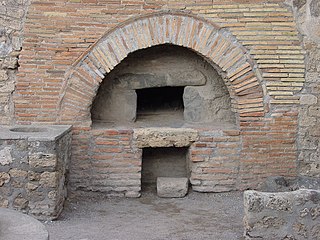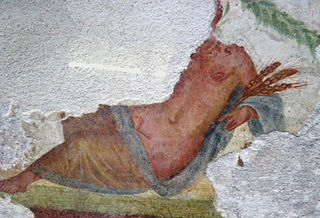Mellona or Mellonia was an ancient Roman goddess said by St. Augustine to promote the supply of honey, as Pomona did for apples and Bubona for cattle. Arnobius describes her as "a goddess important and powerful regarding bees, taking care of and protecting the sweetness of honey."

In ancient Roman religion, Stata Mater was a compital goddess who protected against fires. She had an image (simulacrum) in the Forum, and her cultus, as Festus notes, spread from there throughout the neighborhoods (vici) of the city.

In ancient Roman religion, Strenua or Strenia was a goddess of the new year, purification, and wellbeing. She had a shrine (sacellum) and grove (lucus) at the top of the Via Sacra. Varro said she was a Sabine goddess. W.H. Roscher includes her among the indigitamenta, the lists of Roman deities maintained by priests to assure that the correct divinity was invoked in public rituals. The procession of the Argei began at her shrine.

In ancient Roman religion, the Salii were the "leaping priests" of Mars supposed to have been introduced by King Numa Pompilius. They were twelve patrician youths, dressed as archaic warriors: an embroidered tunic, a breastplate, a short red cloak (paludamentum), a sword, and a spiked headdress called an apex. They were charged with the twelve bronze shields called ancilia, which, like the Mycenaean shield, resembled a figure eight. One of the shields was said to have fallen from heaven in the reign of King Numa and eleven copies were made to protect the identity of the sacred shield on the advice of the nymph Egeria, consort of Numa, who prophesied that wherever that shield was preserved, the people would be the dominant people of the earth.

A flamen was a priest of the ancient Roman religion who was assigned to one of fifteen deities with official cults during the Roman Republic. The most important three were the flamines maiores, who served the important Roman gods Jupiter, Mars, and Quirinus. The remaining twelve were the flamines minores. Two of the minores cultivated deities whose names are now unknown; among the others are deities about whom little is known other than the name. During the Imperial era, the cult of a deified emperor (divus) also had a flamen.
The Robigalia was a festival in ancient Roman religion held April 25, named for the god Robigus. Its main ritual was a dog sacrifice to protect grain fields from disease. Games (ludi) in the form of "major and minor" races were held. The Robigalia was one of several agricultural festivals in April to celebrate and vitalize the growing season, but the darker sacrificial elements of these occasions are also fraught with anxiety about crop failure and the dependence on divine favor to avert it.
In ancient Roman religion, Averruncus or Auruncus is a god of averting harm. Aulus Gellius says that he is one of the potentially malignant deities who must be propitiated for their power to both inflict and withhold disaster from people and the harvests.

Vulcan is the god of fire including the fire of volcanoes, deserts, metalworking, and the forge in ancient Roman religion and myth. Vulcan is often depicted with a blacksmith's hammer. The Vulcanalia was the annual festival held August 23 in his honor. His Greek counterpart is Hephaestus, the god of fire and smithery. In Etruscan religion, he is identified with Sethlans.

In ancient Roman mythology, Salacia[sa.laː.kja] was the female divinity of the sea, worshipped as the goddess of salt water who presided over the depths of the ocean. Neptune was her consort. That Salacia was the consort of Neptune is implied by Varro, and is positively affirmed by Seneca, Augustine and Servius. She is identified with the Greek goddess Amphitrite, consort of Poseidon.

In ancient Roman religion, the Flamen Quirinalis was the flamen or high priest of the god Quirinus. He was one of the three flamines maiores, third in order of importance after the Flamen Dialis and the Flamen Martialis. Like the other two high priests, he was subject to numerous ritual taboos, such as not being allowed to touch metal, ride a horse, or spend the night outside Rome.

In ancient Roman religion, Vagitanus or Vaticanus was one of a number of childbirth deities who influenced or guided some aspect of parturition, in this instance the newborn's crying. The name is related to the Latin noun vagitus, "crying, squalling, wailing," particularly by a baby or an animal, and the verb vagio, vagire. Vagitanus has thus been described as the god "who presided over the beginning of human speech," but a distinction should be made between the first cry and the first instance of articulate speech, in regard to which Fabulinus was the deity to invoke. Vagitanus has been connected to a remark by Pliny that only a human being is thrown naked onto the naked earth on his day of birth for immediate wails (vagitus) and weeping.

In ancient Roman religion, the indigitamenta were lists of deities kept by the College of Pontiffs to assure that the correct divine names were invoked for public prayers. These lists or books probably described the nature of the various deities who might be called on under particular circumstances, with specifics about the sequence of invocation. The earliest indigitamenta, like many other aspects of Roman religion, were attributed to Numa Pompilius, second king of Rome.
Agenoria is a Roman goddess of activity (actus). Her name is presumably derived from the Latin verb ago, agere, egi, actum, "to do, drive, go." She is named only by St. Augustine, who places her among the deities who are concerned with childhood. She is thus one of the goddesses who endows the child with a developmental capacity, such as walking, singing, reasoning, and learning to count. W.H. Roscher includes Agenoria among the indigitamenta, the list of deities maintained by Roman priests to assure that the correct divinity was invoked for rituals.

Iana is the name of an ancient Roman goddess associated with arches and the moon, usually identified as either a form of Diana or the female counterpart of Janus.

Lateranus is an ancient Roman tutelary god of hearths (foci) and a Genius of brick ovens, according to a satirical passage in the Christian writer Arnobius:
Lateranus, as you say, is the god and genius of hearths, and received this name because men build that kind of fireplace of unbaked bricks. What then? if hearths were made of baked clay, or any other material whatever, will they have no genii? and will Lateranus, whoever he is, abandon his duty as guardian, because the kingdom which he possesses has not been formed of clay? And for what purpose, I ask, has that god received the charge of hearths? He runs about the kitchens of men, examining and discovering with what kinds of wood the heat in their fires is produced; he gives strength to earthen vessels, that they may not fly in pieces, overcome by the violence of the flames; he sees that the flavour of unspoilt dainties reaches the taste of the palate with their own pleasantness, and acts the part of a taster, and tries whether the sauces have been rightly prepared.









